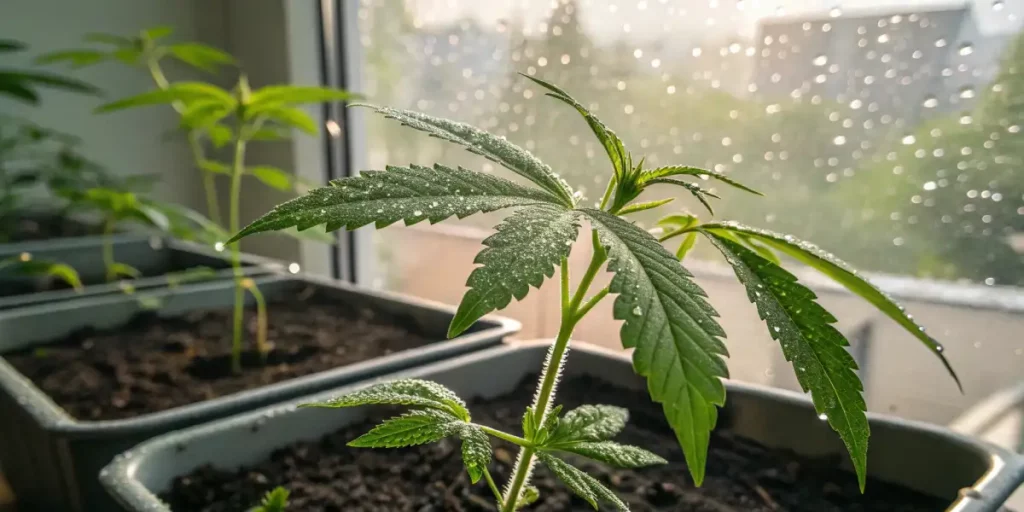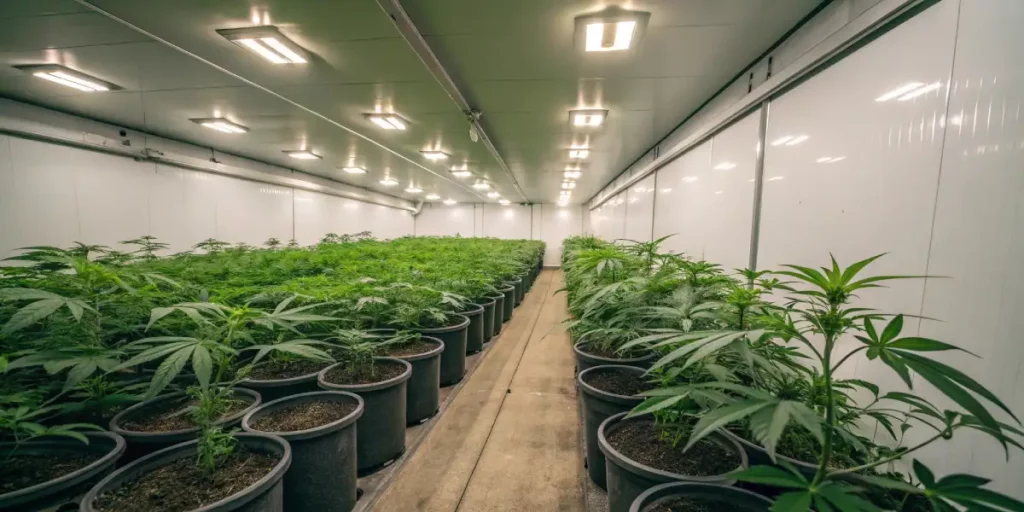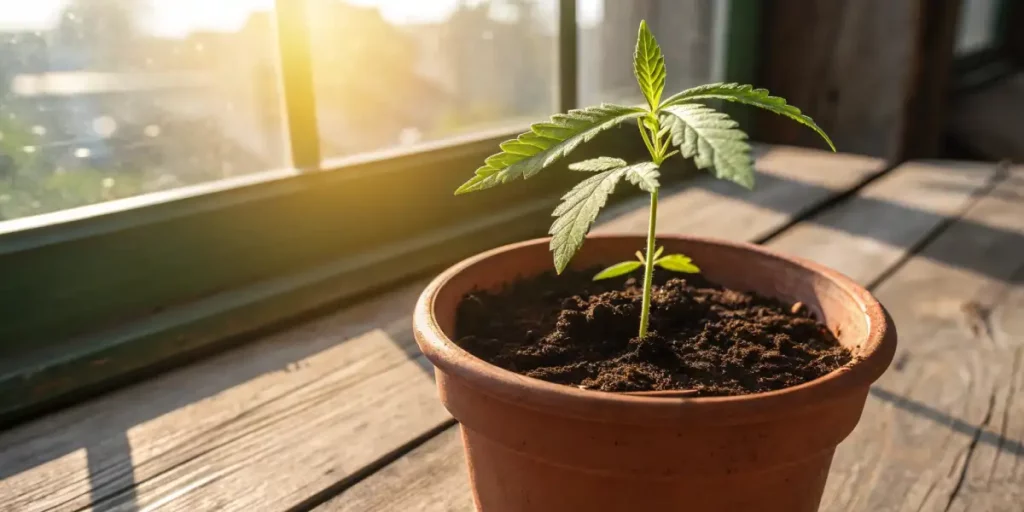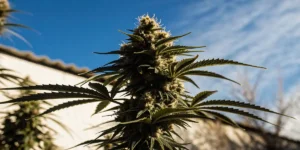Starting your cannabis growing journey can be exciting. It begins with nurturing those tiny seedlings into robust plants. Whether you’re a beginner or an experienced grower, knowing cannabis seedling care is crucial for a successful harvest.
Healthy seedlings lead to bountiful yields. They require the right environment, nutrients, and attention to transform into strong plants. Follow these guidelines to ensure your seedlings thrive.
Choosing the right cannabis strain is essential. For instance, Blue Dream is known for its resilience, making it an excellent choice for beginners. Let’s delve into vital aspects of cannabis seedling care to set your plants up for success.
The Best Soil for Cannabis Seedling Care
Soil quality is critical for healthy seedlings. The best soil for cannabis seedlings is light and airy, allowing roots to breathe. A good soil mix contains peat moss, perlite, and vermiculite.
Avoid heavy soils, as they can suffocate young roots. A well-draining soil mix helps prevent overwatering, a common issue when growing seedlings. Consider using organic soil to provide a nutrient-rich environment.
Consistency in soil quality cannot be overstated. Regularly refreshing the soil with amendments can maintain its fertility and support vigorous growth. Adding worm castings or compost can naturally boost nutrient levels.
Moreover, the best soil for cannabis seedlings often includes beneficial microbes. These microbes assist in breaking down organic matter and making nutrients more accessible to plants. This natural process is essential for sustaining long-term growth and health.
Choosing the Right Soil Mix
Selecting a soil mix tailored for seedlings can make a significant difference. Look for a mix that includes mycorrhizae, beneficial fungi that enhance root growth. This can boost your seedlings’ health and vigor.
Mixing your own soil is an option too. Combine equal parts peat moss, perlite, and vermiculite for a homemade version that supports healthy root development. Consistency is key, ensuring your seedlings get the same nutrients throughout their growth.
When crafting your own soil mix, consider integrating biochar. This component can improve water retention and enhance nutrient availability, further supporting cannabis seedling care. Biochar’s porous nature helps maintain a balanced moisture level in the soil.
Additionally, regularly rotating and aerating your soil can prevent compaction, a critical aspect of maintaining the best soil for cannabis seedlings. This practice ensures that roots have ample space to expand and access oxygen, promoting robust growth.

How to Water Cannabis Seedlings Properly
Watering seedlings correctly is a balancing act. They need enough moisture to grow, but overwatering can drown them. It’s vital to understand how to water cannabis seedlings properly.
Start with a gentle watering schedule. Use a spray bottle to mist the soil lightly. This method prevents soil disturbance and ensures even water distribution. Monitor soil moisture regularly to avoid drying out.
In cannabis seedling care, knowing the specific water needs of each strain can make a significant difference. Some strains may require more frequent watering, while others thrive with less. Adjust your practices based on the particular strain’s preferences.
Moreover, the time of day can impact how to water cannabis seedlings properly. Watering early in the morning can prevent moisture-related diseases and ensure that plants use water efficiently throughout the day.
The Importance of Drainage
Good drainage is essential for preventing root rot. Ensure pots have drainage holes to allow excess water to escape. This simple step can prevent many common cannabis seedling problems and solutions.
Consider using a humidity dome to maintain a consistent moisture level. It’s particularly useful in dry climates, where seedlings might dry out quickly. Ensure the dome allows for airflow to prevent mold growth.
Incorporating drainage layers in your pots can further enhance cannabis seedling care by ensuring that water doesn’t stagnate. Materials like gravel or coarse sand at the bottom of pots can facilitate effective drainage.
Additionally, regularly checking the drainage efficiency of your setup is crucial. Ensure that water is flowing freely through the soil and out of the drainage holes. This practice helps maintain the best conditions for root health.
Ideal Light Conditions for Cannabis Seedlings
Light is a crucial factor in the early stages of cannabis growth. Seedlings need ample light to photosynthesize and grow. Knowing ideal light conditions for young plants sets the foundation for healthy development.
Aim for 18 hours of light per day. This mimics natural summer conditions and encourages growth. Use fluorescent lights or LEDs, which provide the right spectrum without overheating.
Light intensity is another important consideration. While maintaining 18 hours of light, ensure the intensity is not too overwhelming for young seedlings. A PAR meter can help measure light levels accurately.
Furthermore, simulating a gradual increase in light intensity can mimic natural growing conditions, easing seedlings into brighter environments as they mature. This method helps prevent shock and supports steady growth.
Positioning Your Lights
Place lights 2-4 inches above seedlings. This distance prevents burning while ensuring adequate light exposure. Adjust the height as seedlings grow to maintain optimal distance.
Consider a light schedule timer for consistency. It automates the process, ensuring your seedlings receive the same amount of light daily. Consistency in light exposure promotes uniform growth.
Regularly assessing the position of your lights is vital for effective cannabis seedling care. As seedlings grow taller, reposition lights to maintain a safe distance and prevent leaf burn.
Additionally, reflectors or light diffusers can be used to distribute light more evenly across your growing area. This setup ensures that all seedlings receive equal exposure, minimizing the risk of uneven growth.
Cannabis Seedling Nutrient Requirements
Nutrients are vital for seedling development. Seedlings require a balanced diet to grow strong and healthy. Knowing cannabis seedling nutrient requirements can prevent deficiencies and promote vitality.
Start with a mild nutrient solution. Seedlings are fragile and can’t tolerate high nutrient levels. Use a diluted mix designed for young plants, with a focus on nitrogen, phosphorus, and potassium.
As part of comprehensive cannabis seedling care, it’s essential to consider the source of your nutrients. Organic options, such as compost teas or fish emulsions, can provide a more gentle nutrient boost for sensitive seedlings.
Furthermore, knowing the specific cannabis seedling nutrient requirements for different strains can enhance growth outcomes. Some strains may need additional micronutrients, like calcium or magnesium, for optimal development.
Monitoring Nutrient Levels
Regularly check for nutrient deficiencies. Yellow leaves can indicate a lack of nitrogen, while purple stems might suggest a phosphorus deficiency. Address these issues promptly to avoid stunted growth.
Introduce nutrients gradually. Begin with half the recommended dose, increasing slowly as seedlings mature. This approach prevents nutrient burn, a common problem for new growers.
Maintaining a nutrient journal can aid in cannabis seedling care by tracking what has been applied and its effects on growth. This record-keeping helps identify patterns and adjust feeding schedules as needed.
Besides, investing in a reliable pH meter can ensure that nutrient solutions are at the correct pH level, preventing nutrient lockout and promoting healthy absorption by the seedlings.

Common Cannabis Seedling Problems and Solutions
Growing cannabis seedlings can come with challenges. Recognizing common cannabis seedling problems and solutions helps you address issues quickly, ensuring healthy growth.
One prevalent issue is damping off, a fungal infection that affects seedlings. It causes stems to become thin and weak. Prevent this by maintaining proper airflow and avoiding overwatering.
Cannabis seedling care also involves being vigilant about environmental changes. Rapid shifts in temperature or humidity can stress seedlings, leading to poor growth or disease susceptibility.
Moreover, utilizing natural remedies like neem oil can be effective in managing pests and diseases without harming the delicate seedlings. This organic approach supports a healthy growing environment.
Pests and Diseases
Pests like spider mites and aphids can attack seedlings. Regular inspection is crucial to catch infestations early. Use organic pesticides as a safe treatment option.
Mold and mildew thrive in humid conditions. Ensure adequate ventilation and avoid waterlogged soil. A dehumidifier can help maintain optimal humidity levels, preventing these issues.
Besides to organic pesticides, introducing beneficial insects like ladybugs can provide natural pest control while minimizing chemical use.
Implementing a regular cleaning schedule for tools and growing spaces can reduce the risk of disease spread. This preventive measure ensures that seedlings remain healthy and vigorous.
Frequently Asked Questions
What is the best soil for cannabis seedlings?
The best soil for cannabis seedlings is light, airy, and well-draining. A mix of peat moss, perlite, and vermiculite provides the ideal environment. This combination allows for proper root development and prevents overwatering.
Avoid compact soils, as they can restrict root growth and lead to poor seedling health. Regularly check the soil pH to ensure it remains between 6.0 and 6.5, which is optimal for cannabis seedlings.
Incorporating organic amendments can further enhance the quality of the best soil for cannabis seedlings, providing slow-release nutrients and improving soil structure over time.
Monitoring soil temperature is also an important aspect of cannabis seedling care. Warmer soil temperatures can accelerate growth, while cooler temperatures may slow down root development.
How to water cannabis seedlings properly?
Water cannabis seedlings with care to avoid overwatering. Use a spray bottle to mist the soil lightly, ensuring even moisture distribution. Monitor soil moisture to prevent it from drying out completely.
Ensure pots have drainage holes to allow excess water to escape, preventing root rot. Adjust your watering schedule based on environmental conditions and seedling needs.
Utilizing moisture meters can provide precise insights into when to water, supporting effective cannabis seedling care by eliminating guesswork and ensuring optimal hydration.
Additionally, considering the use of rainwater for irrigation can offer a more natural watering option, free from chemicals often found in tap water.
What are the ideal light conditions for cannabis seedlings?
Cannabis seedlings require 18 hours of light per day to thrive. Use fluorescent lights or LEDs placed 2-4 inches above the seedlings. This setup provides the necessary light spectrum without causing heat stress.
Adjust the light height as seedlings grow and monitor for signs of light stress, such as leaf curling or yellowing. Consistent lighting conditions promote healthy and uniform growth.
Incorporating light reflectors can maximize the efficiency of your lighting setup, ensuring all parts of the seedling receive adequate illumination, which is crucial for balanced growth.
Furthermore, investing in programmable timers can automate light cycles, reducing manual intervention and maintaining ideal light conditions for cannabis seedlings effortlessly.
What are the cannabis seedling nutrient requirements?
Start with a mild nutrient solution, focusing on nitrogen, phosphorus, and potassium. Seedlings are sensitive and require a balanced diet for healthy development. Gradually increase nutrient levels as plants mature.
Monitor for signs of nutrient deficiencies, such as yellow leaves or purple stems. Address these promptly to ensure robust growth. Tailor your nutrient plan to each strain for the best results.
Liquid fertilizers can be a convenient option for delivering essential nutrients quickly, offering flexibility in cannabis seedling care by allowing precise control over feeding schedules.
Additionally, exploring the use of foliar feeding can provide immediate nutrient access to leaves, complementing root-based feeding methods and enhancing overall seedling health.
What are common cannabis seedling problems and solutions?
Common problems include damping off, pests, mold, and environmental stress. Prevent damping off by maintaining good airflow and avoiding overwatering. Regularly inspect for pests and use organic treatments to control infestations.
Ensure proper ventilation to prevent mold and mildew. Maintain stable temperatures and humidity levels to avoid stress. By addressing these issues, your seedlings can grow into healthy, productive plants.
Implementing a routine of regular inspection and maintenance can significantly reduce the occurrence of common cannabis seedling problems and solutions, ensuring consistent growth and vitality.
Moreover, keeping detailed records of any issues and their resolutions can provide valuable insights for future growing cycles, enhancing your cannabis seedling care strategy over time.





